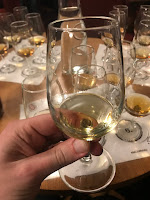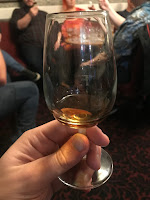 |
| The grain whisky line up |
For our tasting in August, we looked at one of the more forgotten areas of Scottish whisky: grain whisky. Simply put, grain whisky refers to any whisky made in part from grains which aren't malted barley, and can include grains such as corn, wheat, maize and rye.
 |
| Holyrood |
We started off with something from the new Holyrood distillery in Edinburgh, the Scottish capital's first new opening in a century. In fact, what we were drinking was not actually produced there, as it's only been up and running since 2019, but was instead called Sweet Single Grain, bottled under licence using the name 'Holyrood Spirits Merchants' although we don't know where the spirit itself was produced.
It smelt nice, with a good nose all round. Something distinctive in the aftertaste, but we couldn't quite place it at first, although there was a shout for butterscotch. Coats your mouth nicely. As someone said: "not all that much to say about it, but it's lovely." From an AHC - alligator heavy char - cask, a fact which might explain the sweetness we all got. This was 46% and was a very reasonable £39.50.
 |
| Bramble Whisky Co |
Onto dram number two and one of the biggest grain distilleries in Scotland, the North British. Jointly owned by Diageo and Edrington Group, it has an annual output of about 12 million litres, most of which ends up in a variety of well-known blends.
This particular bottle was from a small indie, the Bramble Whisky Company, associated with a local bar. It was four-and-a-half years old, a virgin oak single cask and, like the first bottle, we got ours online from Royal Mile Whiskies. It had plenty going on. We got fruitcake, root liqourice, and a generally quite earthy flavour. Interesting, different, enjoyable, and certainly unusual. One drinker asked whether it was aged in Listerine barrels, although others felt it was a bit on the sickly side. It's £57 and 46%.
 |
| Invergordon |
We were off next to another big old grain distillery. This time it was Invergordon, today part of Whyte and Mackay. And in a bit of a surprise, we soon learned that we had in our hands the oldest whisky ever tasted as part of a club event. It was a bottling of a whisky distilled back in 1972, making it a 48-year-old when it finally went into the bottle: a rarity for many of us members to have a dram older than them! It was the work of another independent bottler, this time Thompson Brothers.
Pear drops on the nose here. Vanilla, caramel and then a bit of fruit. Tropical fruit in fact, like pineapple or even peaches. Some thought it had a bit of a 'meh' finish to it, but others felt it improved after a few sips. A touch spicy maybe, thought someone. Although a good dram, we probably wouldn't pay the £270 price tag again! It was 42%.
 |
| Port Dundas |
Port Dundas in Glasgow used to be another big name in grain distilling, until the distillery was closed and demolished a decade ago, as owner Diageo looked to consolidate its grain output at Cameronbridge (more of which in a moment). Adam had chosen for us one of the later bottlings from the distillery, a 2009 10-year-old under the Cooper's Choice name, a mixture of American oak and Martinique rum casks.
And very nice it was too. Very pleasant and memorable was the consensus, along with "grassy" and "earthy". With water in it became really good, perhaps indicating it was bottled a little too strong. And by too strong, we mean a very chunky 60.5%. At £57 though, we felt this was a bit of a bargain, a more than reasonable price for something like this.
 |
| Cameronbridge |
Port Dundas may have gone but Cameronbridge endures. Located in East Fife, it's the largest grain distillery in Europe, producing 200 litres of the good stuff every minute. And we had another older whisky to try, this time a 36-year-old bottled by Bartels Whisky under the name His Excellency. Indeed, it was a cask strength version of a bottle we'd had before.
This had the nicest nose so far. Caramel, chewy, toffee apple, even fizzy cider. A bit rummy on the nose, we got some sweetness and molasses. Chewy - that word again - when tasted, a bit of water brought out more of the flavour. The finish was perhaps a little harsh, but was also thick and oily. For plenty of members, the clear favourite so far. It was 57.9% and cost us £78.
 |
| Loch Lomond |
To finish, we took the high road, or perhaps by this time of the night it was more like the low road, to Loch Lomond. The distillery is known for being self-sufficient, in so far as it has its own malt and grain distillery. And we were trying a peated version of the Loch Lomond Single Grain.
This had an interesting nose. Irn Bru, fruits and spices, and just a bit peaty or smoky. A rabbit out of the hat suggested someone, and quite a few really enjoyed this. It's unusual to have a peaty grain, and on this occasion we were drinking what was effectively a single malt, but which was not distilled in the batch process but was instead made using the continuous Coffey still method so technically doesn't count as a single malt under Scottish rules. More's the pity, as not only was this a very good whisky, it was a total bargain at just £26. It's 46%.
And so we came to the dram of the night voting. And in an unprecedented development, we had a five-way tie! All the drams from two to six got the same number of votes, so we left it at that rather than trying to force a winner.
Thanks to all members for taking part via Zoom once again, and to Adam for selecting and running us through another great selection of drams!


















































